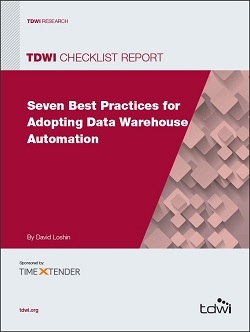
TDWI Checklist Report | Seven Best Practices for Adopting Data Warehouse Automation
December 18, 2015
The word agile conveys a number of meanings. Its simple definition as an adjective is “quick and well-coordinated,” but the term has taken on additional meaning in the context of system design and development, largely in terms of rapid development, increased partnership among information technology (IT) and business partners, and leveraging teamwork to achieve short-term objectives that build toward solving more complex business challenges.
Applying agile development methodologies to data warehousing promises a number of benefits: quicker development and movement into production, faster time to value, reduced start-up and overhead costs, and simplified access for business users. Yet there are some prerequisites to transitioning to using the agile approach for data warehousing:
- Evaluate the existing environment to identify the best opportunities for achieving the benefits of adoption
- Establish good practices for leveraging more agile technologies where possible
- Identify the right technologies to facilitate that transition
There are a number of technologies that accelerate design and development, improve cycle time in producing reports and analyses, and enhance the IT-business collaboration. Some are platform oriented, such as columnar databases, in-memory computing, and Hadoop, which all seek to leverage faster performance to improve analytical results.
Alternatively, data warehouse automation (DWA) tools blend user requirements and repeatable processes to automatically generate the components of a data warehouse environment. These tools simplify the end-to-end production of a data warehouse, encompassing the entire development life cycle, including source system analysis, design, development, generation of data integration scripts, building, deployment, generation of documentation, testing, support for ongoing operations, impact analysis, and change management.
We are rapidly moving away from the monolithic, single-system enterprise data warehouse and toward a hybrid environment that uses the most appropriate technologies to address specific data challenges. That environment will encompass many components and will benefit from reduced complexity through the use of tools like DWA. This checklist discusses seven practices for determining the value proposition of adopting DWA and establishing the foundation that will ease its adoption.